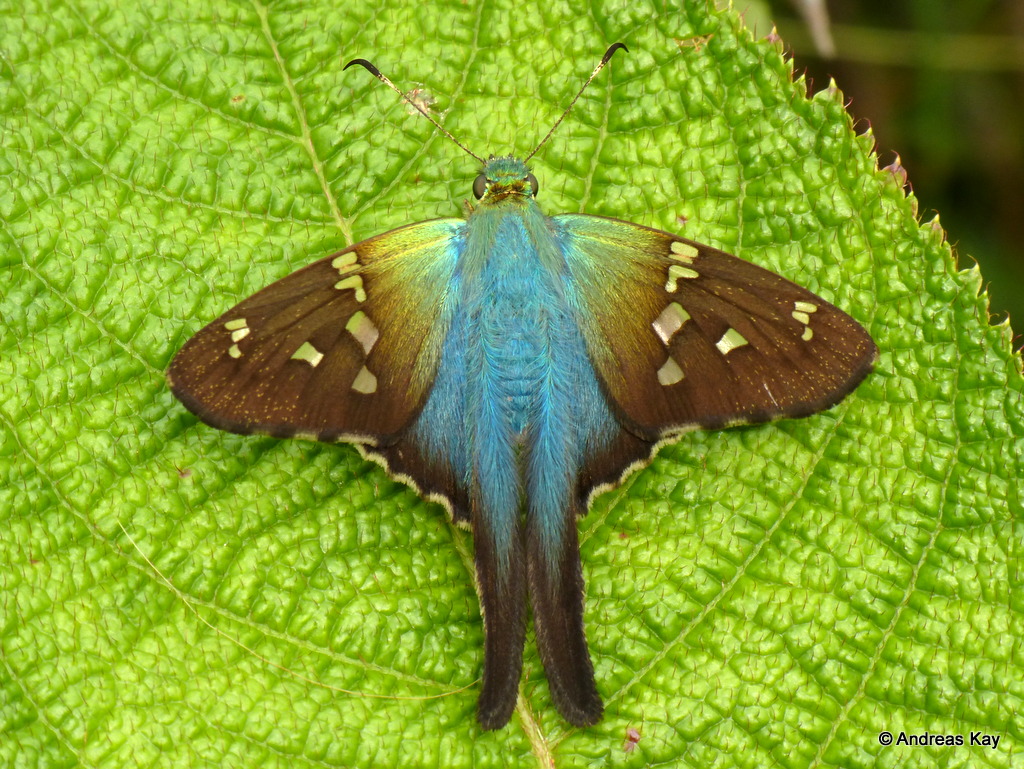Polk County’s Most Wanted – Long-tailed Skipper
Have you seen Long-tailed Skipper (Urbanus proteus)?

Conserving Carolina and botanist/ecologist David Campbell need your help in locating “Polk County’s Most Wanted—Animal,” the Long-tailed Skipper (Urbanus proteus), sometimes referred to as the ‘bean leafroller’. Polk County’s Most Wanted is a community science initiative with a new challenge each month, in which you can expand the scientific understanding of the flora and fauna of Polk County.
Where should I look for Long-tailed Skipper?
The Long-tailed Skipper prefers open, disturbed fields, roadsides, utility right-of-ways, forest edges, and suburban gardens. Adults feed on the nectar of flower from a variety of plants. Adults often roost upside down under leaves and limbs. In our area, adults are most common July through November. Both the adult and caterpillar of this species can be seen this time of year.
How do I identify Long-tailed Skipper?
The Long-tailed Skipper is a species of small, short-winged butterflies with a wingspan of 1 ½” – 2”. They are characterized by a large head and a pair of prominent, dark eyes, and hindwings with long “tails,” like that of a swallowtail butterfly. They are brownish black with several white square to hourglass shaped spots on the outer one half of the forewing, and when the wings are open, an iridescent bluish-green body and base of the wings is visible. The underside of the forewings is brown with white spots and dark bands, the hindwing has brownish blotches, and the margins are bordered in white.
The mature larva has a relatively large black head with reddish-brown patches and it appears constricted at its base. It is yellowish green with two thin yellow lines running vertically down the length of the body on both sides, turning an orange-yellow tint at the end.

More about the Long-tailed Skipper
Skipper Butterflies display many structural features of both moths and butterflies, they are stocky with a large head, they have widely spaced, hooked antennae, and a chunky body and short wings. These smallish butterflies are rapid, erratic fliers. The Long-tailed Skipper is a member of the Spread-wing Skippers (Pyrginae), the second largest group of skipper butterflies, distinguished from other skipper butterflies by their tendency to rest with their wings open.
The Long-tailed Skipper can be found in tropical to subtropical South America, southern parts of Argentina, and a small region in the southern US, including Texas and Florida. Occasionally, the butterflies stray and colonize north to Connecticut, southern Illinois, eastern Kansas, southern Arizona, and southern California.
For protection while maturing, caterpillars cut and fold host plant leaves then wrap themselves in the leaf forming tube-like structure. Silken strands produced by the caterpillar are used to hold the tube together. After two to three weeks, it forms a tan to reddish brown pupa that appears to be smudged with a dusty white pattern, resembling dead leaves of the host plant. After 10 days, the adult emerges. During the breeding season, adults usually live up to two weeks, and there can be three or more generations per year, especially in the southern states. Long-tailed Skippers cannot tolerate freezing temperatures in any stage of their life cycle, and they migrate to tropical and subtropical areas to overwinter as reproductively arrested adults.
What can you do?
If you think that you have seen a Long-tailed Skipper in the adult or larval stage in Polk County, please contact Pam Torlina at [email protected] and, if possible, provide a clear image for evaluation.
For More Information
See more about “Polk County’s Most Wanted.” Download and print a “Pocket Guide” with all of the “Most Wanted” plants, animals, and habitats that you can be on the lookout for when you’re out in the field!
A Biological Inventory of Polk County
Now available for download: “An Inventory of the Significant Natural Areas of Polk County, North Carolina,” a culmination of David Campbell’s seven years in the field documenting the rare and significant flora and fauna in Polk County. Hard copies are available, at cost, on Amazon too!